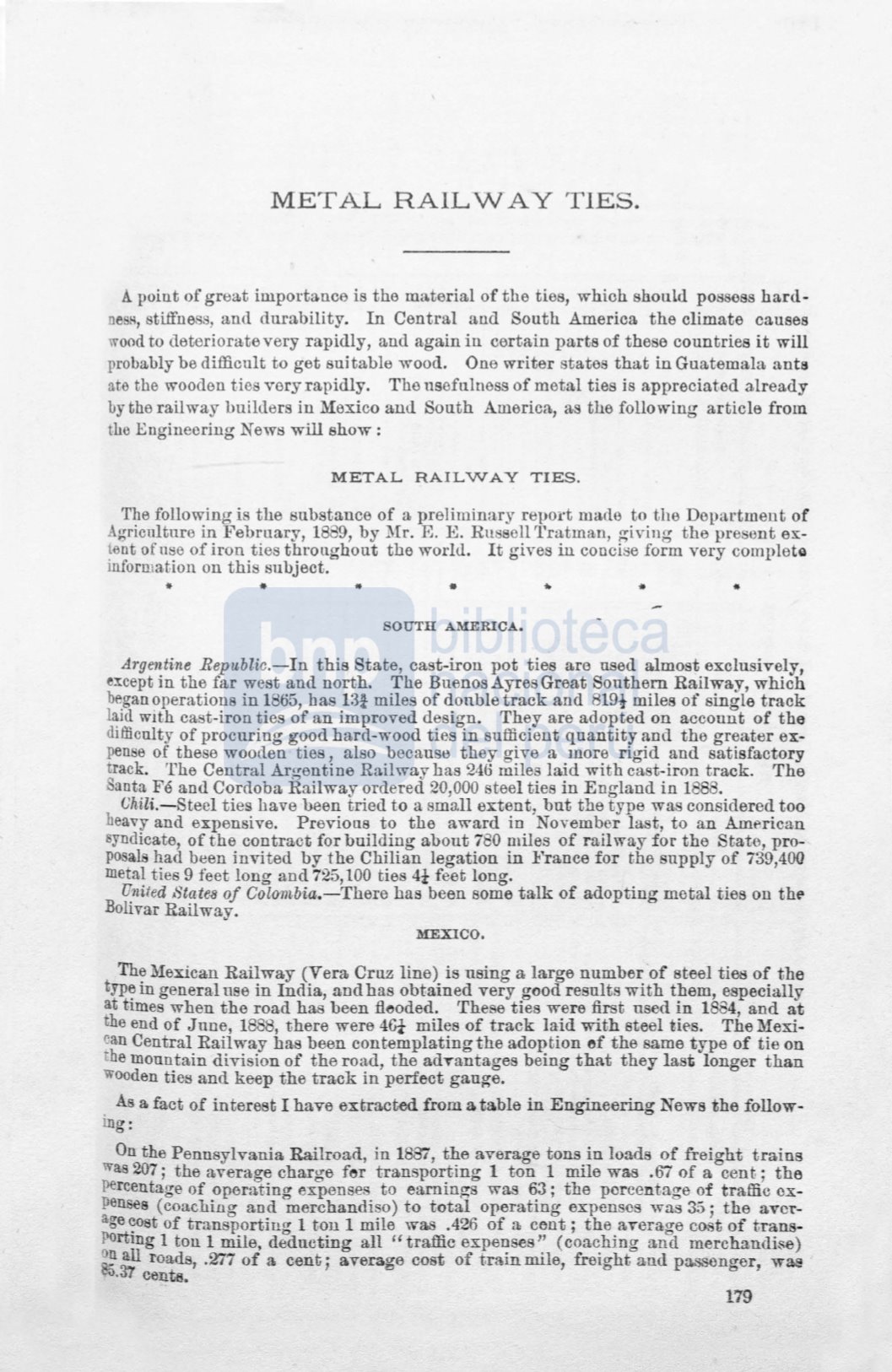

METAL RAILW A Y TIES.
A.
point of great importance is the material of the ties, which should possess hard–
ness, stiffness, and dnrability.
In
Central and South America the climate causes
wood to deterioratevery rapidly, and again in certain parts of these countries it will
probably be difficult to get suitable wood. One writer states that in Guatemala anta
ate the wooden ties very rapidly. The usefulness of metal ties is appreciated already
by
the railway lmilders in Mexico and South America, as the following article from
the Engineoring News will show :
METAL RAILWAY TIES.
The following is the substance of a pre1iminary rep01·t made to the Department of
Agriculture
in
Ji'ebruary,
1889,
by Mr. K
E.
Russell Tratman,
~iving
the present ex:–
tent ofnse of iron ties throughout the worlu. It gives
in
concise form very completo
information on this subject.
SOUTH AMERICA.
Argentine Republic.-In
this State, cast-iron pot ties are nsed almost exclnsively,
except in the far west and north. The BuenosAyresGreat Southern Railway, which
began operations in
1865,
has
13-1
miles of donble track and
819-t
miles of single track
laid with cast-iron ties of an improved design. They are adopted on account of the
difficnlty of procuring good hard-wood ties in sufficient quantity and the greater ex–
pense of these wooden ties, also because they give a more rigid and satisfactory
track. The Central Argentine Ra.ilwayhas 246 miles laid withcast-iron track. The
anta Fé and Cordoba Railway orclered
20,000
steel ties in England in
1888.
Chili.- Steel ties have been tried to a
sma.llextent, but the type was considered too
heavy and expensive. Previous to the award in November last, to an American
yndicate, of the contract for building about
780
miles of raílway for the State, pro–
posa.lshad been invited by the Chilian legation
in
J<'rance for the supply of
739,400
metal ties
9
feet long and
725,100
ties
41
feet long.
United Btatea oj
Colmnbia.- There has been sorne talk of adopting metal ties on tht>
Bolívar Railway.
MEXICO.
TheMexican Railway (Vera Cruz line) is using a large number of steel ties of the
type in general use in India, and has obtained very good results with them, especially
at times when the road has been
:fi~oded.
'fhese ties were first used in
1884,
and at
the end of June,
1888,
there were 4Gt miles of track laid with steel ties. The Mexi–
can Central Railway has been contemplatingthe adoption ef the same type of tie on
the mountain division of the road, the ad-vantages being that they last longer than
wooden ties and keep the track in perfect gauge.
As
a fact of interest I have extractad from atable
in
Engineering News the follow–
mg :
On the Pennsylvania Railroad, in
1887,
the average tons in loads of freight trains
was 207; the average charge
f~r
transporting
1
ton
1
mile was .67 of a cent; the
"Percentage of opemting expenses to
earnin~s
was 63; the porcentage of traffic ex–
penses (coachiog and merchandiso) to total operating expenses was
35;
the aver–
age
~ost
of tra.nsporting
1
ton
1
mile was .426 of a cent ; the average cost of trans–
Porting
1
ton
1
mile, deduoting all "traffic expen es" (coaching and
merchandi~e)
,})
all roads,
.'Z17
of a cent; average cost of t.rain mile, freight and passenger, was
.,\),37
cents.
179
















